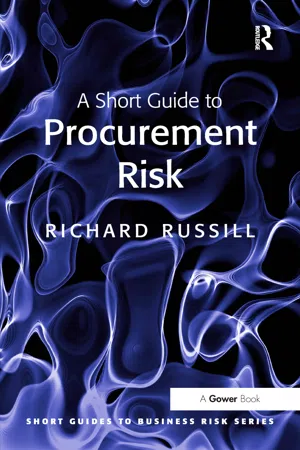
- 142 pages
- English
- ePUB (mobile friendly)
- Available on iOS & Android
A Short Guide to Procurement Risk
About This Book
Increasingly, top executives view supply markets as sources of competitive advantage and as means of achieving strategic objectives. Procurement is the management activity that makes this happen, and this process depends on a superior risk management capability if it is be effective. Yet, despite its importance, Procurement Risk Management is surprisingly under-developed. Recent Global Risk surveys have pinpointed Supply Chain Vulnerability as one of the four key global risks for the next decade. What is less well known is that this is only half of the story... risk exposures also exist inside the company and can be just as damaging. No company is an island; it needs suppliers as well as customers. Conventional wisdom puts great emphasis on managing certain aspects of business such as customers; operations; strategy and finances. Typically, however, much less regard is paid to external suppliers and the risks present in dealing with them. As a minimum, suppliers are the sources of materials, services and expert attention which enable the company to feed its business model. When done well, a risk-aware procurement process provides the bonus of competitive advantage, with the ability to capitalise, on the occurrence of unexpected events. This short guide explains just how to do it. Each chapter explores the topic in hand, outlines the risks and the remedies available and offers guidance on the principles and risk prevention.
Frequently asked questions
1
Procurement and Risk – The Big Picture
Procurement’s Place in the Business … and the Need to Get it Right
- Vulnerabilities in physical supply chains are poorly understood and managed. This has been identified as one of four emerging risk issues likely to impact in the years to come.1 The recent capture by Somali pirates of a cargo ship serves as a stark lesson that this is no theoretical forecast and that the ‘unimaginable’ does happen. Increasing supplier bankruptcies coming in the train of the economic crisis only add to supply chain woes.
- High growth in the Chinese economy in 2007–08 drove huge price increases in commodity raw materials along with additional concerns about shortages of supplies for Western economies. Freak weather conditions in Brazil and India caused wholesale prices of sugar to hit a near 28-year high, up 80 per cent in 2009 alone. An expected knock-on effect will be a global shortage of sweeteners as big importers of sugar switch into them as a substitute.
- Although its supplier had breached a contract, a customer company had to accept a court ruling in favour of the supplier because the buyer had not exercised the contract’s termination clause in a timely manner.2
- The value of procurement fraud in the UK increased by 347 per cent during 2008.3
- And truth continues to be stranger than fiction. Workers at a recently bankrupted French company supplying the car industry threatened to blow it up if their redundancy compensation claims were not satisfied. ‘The gas bottles are in the factory. Everything is ready to blow it up,’ said a union representative.4
WHAT ARE THE RISKS OF NO
PROCUREMENT RISK MANAGEMENT?
- Profit, budgets, and cash flow are all hurt:
- – substantial reductions in shareholder value occur
- – need to maintain a far higher than necessary level of risk capital
- Customers kept waiting or turned down.
- Helplessness in dealing with supplier price increases.
- Output prices forced up with loss of competitiveness.
- Poor supplier performance or, worse, allocation or loss of supply.
- Fragmentation and loss of procurement negotiating leverage.
- Legally unsound contracts heavily biased in suppliers’ favour.
- Unproductive use of human resources.
- Insufficient 'internal challenge’ of specifications and decision-making.
- Decision-makers prey to the tactics of salespeople.
- Political embarrassment or damage to company image and reputation.
- Vulnerable to internal and external fraud.
- Exploited and manipulated by monopolies, cartels and hostile contractors.
- Supplier innovations passed to competitors.
- Beaten to the market by competitors with new products or services.
- Too quick or too late to market with own new offerings.
- Damage to brand and company reputation by unethical behaviour or incompetence.
- Organisation is penalised for non-compliance with regulatory requirements.
- Organisation’s activities become subject of public scrutiny and investigation.
‘Playing with Fire’: The Elements of Procurement Risk Management
Table of contents
- Cover Page
- A Short Guide to Procurement Risk
- Copyright Page
- Contents
- List of Figures
- Introduction
- 1 Procurement and Risk – The Big Picture
- 2 External Dependencies
- 3 Market Conditions and Behaviours
- 4 Procurement Process
- 5 Management Controls
- 6 Handling the Unexpected
- 7 Procurement Risk Management – An Integrated Approach
- Index